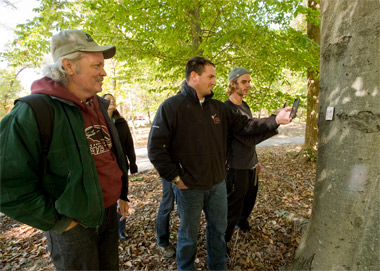
Getting the identification -- Jon Schoonover, associate professor of forestry at Southern Illinois University Carbondale, center, shows students in his tree identification course how to use a QR code on a tree to access the website he developed with the Center for Teaching Excellence. The website identifies the tree by both common and Latin scientific names, and shows students identification markers such as leaves, twigs and buds, and bark. Schoonover stressed that the QR codes are attached to the tree without injury to the tree. With Schoonover are foresty majors from left, Walter Meszaros, a senior from St. Augustine, Fla., and right, Christian Tambellini, a junior from Nashville, Tenn. (Photo by Stephen Buhman)
October 29, 2013
Trees are tutors in SIU forestry program
CARBONDALE, Ill. – Forestry students in a tree identification course have a surprising new tutor at Southern Illinois University Carbondale -- the trees themselves.
Jon Schoonover, associate professor of forestry, and a team of graduate students are putting QR codes on trees, and near shrubs and vines, in Thompson Woods and around Campus Lake. The QR codes, when scanned by a smartphone with a code scanning application, link to a dedicated website that tells the user about the tree, shrub or vine. The program is the only one like it in the state, and one of very few at colleges and universities nationwide.
“The website gives the common name of the tree, the Latin botanical name, and identifying information such as leaf shape, twigs and buds, bark, and fruit,” Schoonover said. “It’s important for students to get out and see the tree where it is, to touch the bark and smell and feel the tree. You can’t get that from a website or a textbook.”
The team is affixing the QR codes on white rectangles at about four and a half feet high on the side of the tree most visible to the nearest walkway, using aluminum nails that do not hurt the trees. Schoonover plans to identify examples from each of the 135 species of tree, shrub and vine taught in the tree identification course. Ultimately, he hopes to have three examples per species to help students recognize normal variations in life stages of the plants and trees. A comprehensive tree map will help students find species examples directly rather than by chance wandering.
Initially, Schoonover wanted to create a smart phone application for this project. However, he also wanted to incorporate the Dell tablets each incoming freshman student received at the beginning of the fall semester. The QR code and website link worked better with the tablets.
“We’ll have several stages for this,” Schoonover said, noting that he wants to tie in the project with a tree-mapping project begun earlier. “This is just 1.0. I’d still like to have an application, one that ties into GPS and could give an alert when the user is near a tagged tree.”
Schoonover credited the Center for Teaching Excellence on campus with the technological assistance.
“I had the idea, but I don’t know how to make an application or a website. They took the photos, made the website and the QR code, and they are making little improvements as students make suggestions.”
Any smart phone can read the codes. Schoonover said he hopes members of the community who walk the loop trail at the lake will take advantage of the program as well.
